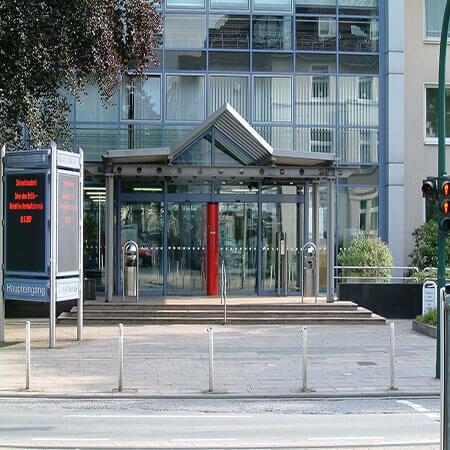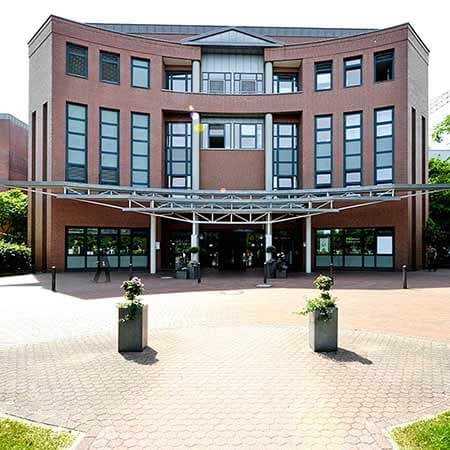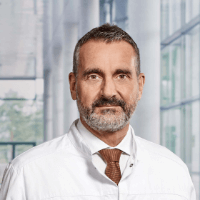Pulmonary Valve Stenosis — Pulmonary Valve Pepair (reconstruction): treatment in the Best Hospitals in the World
Treatment prices are regulated by national law of the corresponding countries, but can also include additional hospital coefficients. In order to receive the individual cost calculation, please send us the request and medical records.

Department of Cardiothoracic Surgery
According to the Focus magazine, the Department of Cardiothoracic Surgery ranks among the top German medical facilities specializing in the surgical treatment of diseases of the cardiovascular system and lung cancer! The department offers the full range of surgical services for the treatment of diseases of the cardiovascular system, respiratory tract, including heart and lung transplantation, artificial heart implantation. The therapeutic options include aortic surgery, coronary artery bypass grafting, transplantation surgery, surgical treatment of heart rhythm disorders (arrhythmias), minimally invasive surgery, surgical treatment of the heart valves, including reconstructive interventions. All operations are performed using state-of-the-art technology and in accordance with the current recommendations of professional societies.






Department of Cardiac Surgery
The Department of Cardiac Surgery provides a full range of surgical treatment in its area of specialization. Special emphasis is placed on heart valve repair and replacement surgery, coronary artery bypass grafting, thoracic aortic surgery, adult congenital and acquired heart disease surgery, pacemaker and defibrillator implantation, and artificial heart implantation for severe heart failure. Many heart operations are performed using minimally invasive techniques, which has a positive effect on the healing of the surgical wound. Minimally invasive cardiac procedures also reduce surgical risks and contribute to a rapid recovery of the patient in the postoperative period. Surgical treatment of cardiac pathologies is performed in advanced operating rooms equipped with the latest technology. The cardiac surgeons of the department successfully perform routine and complex surgical procedures, saving the lives of thousands of patients. The specialists work in accordance with current clinical protocols and follow the recommendations of the German Society for Thoracic and Cardiovascular Surgery (DGTHG).


Department of Cardiothoracic Surgery and Vascular Surgery
The Department of Cardiothoracic Surgery and Vascular Surgery provides effective surgical treatment for diseases of the heart, respiratory system, and blood vessels. The team of cardiac surgeons operates on patients with heart valve pathologies, coronary heart disease, heart failure, and heart rhythm disturbances. In the field of thoracic surgery, the key focus is on the surgical removal of lung tumors and lung metastases. The specialists in this area also perform surgery to repair chest wall deformities. In the field of vascular surgery, interventions for abdominal and thoracic aortic aneurysms are most often performed here. The department's vascular surgeons are also exceptionally competent in the treatment of peripheral occlusive arterial disease. A great advantage for the department's patients is that almost all surgical interventions are performed using minimally invasive techniques, so there is no need for a long postoperative recovery. The department's operating rooms are equipped with state-of-the-art technology. This allows for effective and safe treatment. The priority is always personalized medical care for patients.






Pulmonary valve stenosis is predominantly a congenital heart disease, so the main group of patients are children. Occasionally, it is acquired, for example, it may develop as a result of previous rheumatic diseases, and in this case, it is usually combined with defects in other heart valves. Pulmonary valve stenosis is successfully treated abroad, usually with a minimally invasive procedure.
Content
In most cases, doctors perform balloon heart valve repair through an endovascular approach. Much less often, they perform open heart valve repair surgery or heart valve replacement surgery with a thoracotomy. Such operations are performed when stenosis is combined with insufficiency or in the presence of other heart defects.
You can seek medical attention from the University Hospital Ulm, the University Hospital Essen, or the University Hospital Oldenburg.
The specialists from the Booking Health company will take care of all the arrangements for your trip. We will help you select a clinic, book hotel and airline tickets, and translate your medical records into German or English. We will also meet you at the airport abroad and take you to the hospital by car.
What surgical procedures can be performed for pulmonary valve stenosis?
The main treatment method for the disease is pulmonary valve repair. It is rarely performed using an open approach. Open-heart surgery is performed only when there is a combination of pulmonary valve stenosis with other valvular defects or cardiovascular diseases that require surgical treatment.
A minimally invasive balloon pulmonary valve repair is usually performed for stenosis. Doctors insert a catheter through an incision in the groin, deliver a balloon through the femoral vessels to the heart valve area, and inflate it. The balloon expands and enlarges the heart valve opening.
Less often, cardiosurgery doctors perform pulmonary valve replacement surgery. In recent years, artificial heart valves have increasingly been implanted using an endovascular approach. The prosthesis is also inserted through an incision in the groin and fixed in the pulmonary artery immediately after the balloon valve repair. These operations are safe, non-traumatic, and the recovery time after them is minimal.
In rare cases, pulmonary valve stenosis treatment is performed using open surgery. Doctors can implant a biological or mechanical prosthesis for a patient. Preference is given to biological artificial heart valves since mechanical ones are too often complicated by thrombosis.
Surgery results
Pulmonary valve repair usually provides good long-term results. Most patients will not need any revision surgical procedures in the future. Valvular insufficiency may rarely develop as a result of heart valve repair surgery. In such cases, heart valve replacement surgery may be required. If you have your surgery at reputable clinics, the risk of developing pulmonary valve insufficiency as a result of stenosis treatment will be minimal.
After heart valve replacement surgery, the artificial valve will have to be replaced after a few years or decades. In children, it is usually replaced after 5-10 years, and in adults, doctors perform repeated surgery every 15-30 years. Revision heart valve implantation can be performed using a minimally invasive endovascular technique.
With high success rates, you can receive treatment for pulmonary valve stenosis abroad. The Booking Health website presents the best hospitals with cardiosurgery departments. You can compare the surgical treatment costs at different cardiosurgery departments abroad and choose a medical care program at the best price. Our specialists will help you select the best clinic and arrange your trip.
Authors:
The article was edited by medical experts, board-certified doctors Dr. Nadezhda Ivanisova and Dr. Vadim Zhiliuk. For the treatment of the conditions referred to in the article, you must consult a doctor; the information in the article is not intended for self-medication!
Sources:

